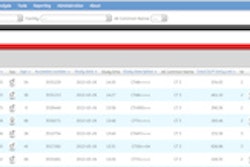
The radiation dose from x-ray exams and fluoroscopic imaging procedures declined on average by 10% between 2005 and 2010, according to the latest survey results of the U.K. National Patient Dose Database (NPDD). Whether this statistic reflects the impact of greater patient safety awareness or increasing use of lower-dose modalities is not known, however.
Typical doses have decreased by nearly 50% since radiology reference doses were collected from a survey conducted in the mid-1980s, according to Paul Shrimpton, PhD, co-author of the NPDD report. He commented upon the latest survey in a letter to the editor of the British Journal of Radiology, published on 1 October.
The NPDD was established in 1992 after publication that year of a national protocol for patient dose measurements in diagnostic radiology. Data about radiation doses from CT exams are collected separately for a different survey.
Every year since 1995, at five-year intervals, the Centre for Radiation, Chemical and Environmental Hazards of the Health Protection Agency has collected and published data about nearly 50 types of examinations performed at hospitals throughout the U.K. The objective of the surveys has been to set national reference doses for x-ray, fluoroscopy, and dental radiography exams in order to facilitate improvements in patient protection (BJR, October 2012, Vol. 85:1018, pp. e957-e958).
A total of 320 hospitals and 4,000 dental practices throughout the U.K. participated in the 2010 survey. They represented about 23% of all radiology facilities and about one-third of all dental practices licensed in the country, a mix of public (85% of the hospitals) and independent healthcare facilities.
The 2010 database, covering a period of time from January 2006 to December 2010, includes 165,000 entrance surface doses and 185,000 dose area products (DAP) for single x-ray exams. For fluoroscopy, 221,000 DAP measurements and 146,000 fluoroscopy times were collected for complete exams. This represents twice as many doses than what was obtained for the previous survey in 2005, according to Shrimpton and his retired colleague, David Hart, PhD, the survey report's principal author.
The report includes national reference doses based on the rounded third-quartile values of the distributions of room mean doses. National reference doses have been published for 38 types of adult diagnostic x-ray exams, three types of pediatric x-ray exams, and seven types of adult interventional procedures. National reference doses have also been published for intraoral and panoramic dental radiographs for both adults and children. Medical and dental x-ray data are each kept in their own database.
The database also includes information on factors that might affect a dose, such as patient size, the type of imaging equipment used, and the examination technique. Information is organized in four types of files. One file contains information about participating hospitals. Another file records data about each radiology suite in which exams were performed, obtaining details about the radiography equipment used. The remaining two files include anonymized data about individual patients, recording age, height, weight, and dose measurement, or groups of patients, for whom the mean dose and the number of patients is supplied. Imaging technique information also is collected.
The surveys have shown a steady shift from use of film-based x-ray equipment to computed radiography (CR) equipment to the use of flat-panel digital detectors (FPD) of direct radiography (DR) equipment. Shrimpton observed that only film-based x-ray equipment was used in 1995. By 2010, film-based equipment represented only 3% of x-ray equipment in use.
Influence of imaging equipment on patient dose
The authors believe that increasing use of flat-panel detector DR equipment that has replaced film-based x-ray equipment and is starting to be purchased instead of CR equipment may be a key reason why average radiation dose has declined. They advocate the acquisition of DR equipment instead of CR equipment for this reason. "Switching from film to CR does not appear to be the best long-term strategy for lowering doses," they wrote.
CR equipment became available for sale in the U.K. in 1989. Flat-panel detectors became available in 2000. With the implementation of PACS, and because a CR conversion to digital imaging was less costly than a DR conversion, many hospitals throughout England and Scotland replaced film-based equipment with CR equipment. This was reflected in data from the 2005 survey. While 55% of the radiology rooms reporting still used film-based equipment, 40% used CR. Only 5% reported use of FPD DR equipment, almost all exclusively in cardiac catherization laboratories.
However, just five years later, 32% used FPD DR equipment, a more than sixfold increase. By comparison, the use of CR equipment had risen to 65%. With the exception of the 3% still using film, film-based equipment had been superseded by digital technology.
What the 2010 survey also revealed was that radiology departments that have adopted DR equipment are using it to achieve optimal dose reduction. In 2005, this equipment had been set at a higher dose level than film-based equipment.
There was a small increase in entrance surface doses for chest radiographs between the 2005 and 2010 survey. The reason for this could not be determined.
The survey also revealed that while the variation in doses reported by survey participants had narrowed, it still was not consistent. "There is further scope for patient dose reduction," the authors concluded.
The authors encourage the use of electronic medical records, RIS, and PACS to change the way that data have been collected. Paper and simple software spreadsheets have been the mode to date. This can and should change, the authors emphasized.
They would like to see the systematic collection and collation of data for monitoring national doses, ideally in intervals much shorter than every five years.
The detailed 87-page survey report may be accessed on the Health Protection Agency website.



















